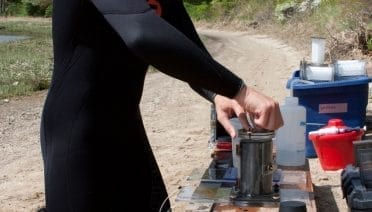Press Room
A three-year study into the cause of local area red tides is set to begin March 21. A team of researchers from the National Park Service, U.S. Geological Survey, and Woods Hole Oceanographic Institution will be examining the cause of…
While JapanÃÂÃÂÃÂÃÂÃÂÃÂÃÂÃÂs 9.0-magnitude earthquake and accompanying tsunami represent a devastating natural disaster for the countryÃÂÃÂÃÂÃÂÃÂÃÂÃÂÃÂs residents, scientists should also seize upon the massive temblor as an important learning tool for future quakes around the world, including the Pacific Northwest coast of the United States, according to experts from the Woods Hole Oceanographic Institution (WHOI).
The Woods Hole Oceanographic Institution (WHOI) ranked second of the ten best places to work for postdoctoral researchers, according to a 2011 survey by the magazine The Scientist. The rankings included 76 US institutions.
With a mission of exploring the potential impact of iron fertilization of the oceans to reduce the amount of carbon dioxide (CO2) in the Earth’s atmosphere, Woods Hole Oceanographic Institution (WHOI) Senior Scientist Ken Buesseler has helped lead the organization…
The microscopic phytoplankton Aureococcus anophagefferens, which causes devastating brown tides, may be tiny but it’s a fierce competitor. In the first genome sequencing of a harmful algal bloom species, researchers found that Aureococcus’ unique gene complement allows it to outcompete…
For 30 years, two General Electric facilities released about 1.3 million pounds of polychlorinated biphenyls (PCBs) into New YorkA?s Hudson River, devastating and contaminating fish populations. Some 50 years later, one type of fishA?the Atlantic tomcodA?has not only survived but appears to be thriving in the hostile Hudson environment.
They were called the Eighth Wonder of the World. Until the late 19th century, New Zealand’s Pink and White Terraces along Lake Rotomahana on the North Island, attracted tourists from around the world, interested in seeing the beautiful natural formations…
Hal Caswell, a senior scientist in the Biology Department at Woods Hole Oceanographic Institution (WHOI), was awarded a 2010 Humboldt Research Award by the Alexander von Humboldt Foundation in Bonn, Germany. The award is given “to internationally renowned scientists and…
To combat last year?s Deepwater Horizon oil spill, nearly 800,000 gallons of chemical dispersant were injected directly into the oil and gas flow coming out of the wellhead nearly one mile deep in the Gulf of Mexico. Now, as scientists begin to assess how well the strategy worked at breaking up oil droplets, Woods Hole Oceanographic Institution (WHOI) chemist Elizabeth B. Kujawinski and her colleagues report that a major component of the dispersant itself was contained within an oil-gas-laden plume in the deep ocean and had still not degraded some three months after it was applied.
Woods Hole Oceanographic Institution (WHOI) President and Director Susan K. Avery and Senior Scientist Scott C. Doney have been elected Fellows of the American Association for the Advancement of Science (AAAS).
In the vast ocean where an essential nutrient?iron?is scarce, a marine bacterium that launches the ocean food web survives by using a remarkable biochemical trick: It recycles iron.
Alexander Graham Bell once said that when one door closes another one opens, and the open doors of the Woods Hole Oceanographic Institution (WHOI) Data Library and Archives are making it possible to help preserve the voluminous archives of GLOBEC, a study of Global Ocean Ecosystem Dynamics, which closed at the end of 2009.
The multi-million dollar upgrades to the storied deep-diving research submersible Alvin will be the focus of a press conference on December 15 at the 2010 American Geophysical Union meeting in San Francisco, CA. Upgrade Project Principal Investigator Susan Humphris, a WHOI geologist, will provide details of the improvements to the sub’s capabilities and its value to the U.S. scientific community.
The U.S. National Deep Submergence Facility (NDSF) has had a growing and important role in the ocean science community’s response to the 2010 Deepwater Horizon oil spill in the Gulf of Mexico. With the recent R/V Atlantis/Alvin expedition (Nov. 8…
Right now, it looks a little like one of those plastic containers you might fill with gasoline when your car has run dry. But Scott Gallager is not headed to the nearest Mobil station. The Woods Hole Oceanographic Institution (WHOI) biologist has other, grander plans for his revolutionary Swimming Behavioral Spectrophotometer (SBS), which employs one-celled protozoa to detect toxins in water sources.
It may take years before scientists determine the full impact of the 2010 Deepwater Horizon oil spill in the Gulf of Mexico. But, utilizing the human-occupied submersible Alvin and the autonomous underwater vehicle (AUV) Sentry, researchers are about to investigate?and view first-hand?the possible effects of the spill at the bottom of the Gulf. And, from Dec. 6-14, the mission will be relayed to the public as it happens on the Woods Hole Oceanographic Institution?s (WHOI) Dive and Discover website (http://divediscover.whoi.edu).
The Earth is constantly manufacturing new crust, spewing molten magma up along undersea ridges at the boundaries of tectonic plates. The process is critical to the planet?s metabolism, including the cycle of underwater life and the delicate balance of carbon in the ocean and atmosphere. Now, scientists at the Woods Hole Oceanographic Institution (WHOI) have observed ocean crust forming in an entirely unexpected way?one that may influence those cycles of life and carbon and, in turn, affect the much-discussed future of the world?s climate.
In a significant step toward a new era in the collection and understanding of ocean science data, the Woods Hole Oceanographic Institution (WHOI) has received a grant of more than $2 million from the Gordon and Betty Moore Foundation for work in imaging informatics in oceanography.
The Woods Hole Oceanographic Institution (WHOI) has launched a video campaign on the world’s biggest stage to highlight the importance of the planet’s largest life-sustaining feature—the ocean. The three-month ocean awareness campaign features 15-second video spots that air every hour…
The ordinary squid, Loligo pealii?best known until now as a kind of floating buffet for just about any fish in the sea?may be on the verge of becoming a scientific superstar, providing clues about the origin and evolution of the sense of hearing.



